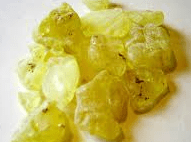Mastic is one of those spices that seems to hold the secrets of ancient times. With its unique, piney flavour and long history, this resin from the mastic tree is both a culinary treasure and a medicinal marvel. Let’s dive into the fascinating world of mastic, a spice that has been cherished for centuries.
What Is Mastic?
Mastic is the resin harvested from the mastic tree (Pistacia lentiscus), a small evergreen tree native to the Mediterranean region, especially the Greek island of Chios, where it has been cultivated for over 2,500 years. The tree produces small droplets of resin that, once collected and dried, harden into a crystal-like substance. These hardened pieces of resin are then ground into a fine powder or used as whole pieces in cooking.
Mastic has a distinct flavour that’s often described as pine-like, with hints of turpentine and a subtle sweetness. It’s unlike most spices, with a resinous, slightly bitter edge that makes it particularly unique.
A Rich History
Mastic has a deep historical significance. In ancient Greece, mastic was prized for its culinary, medicinal, and even cosmetic properties. The resin was used in perfumes, as a natural gum, and even as an ingredient in ancient wine-making. It was also thought to have digestive properties and was used to treat a variety of ailments, from bad breath to stomach issues.
In modern times, mastic is still an important part of Greek culture, often featured in traditional recipes and local products, such as mastic liqueurs and sweets.
How Does Mastic Taste?
Mastic has a piney, resinous flavour with a hint of sweetness and a slight bitterness. The taste is quite distinct—it’s herbal, almost woody, and can be a little challenging for some. However, when used in moderation, mastic adds a complex, aromatic depth to both sweet and savoury dishes, making it a favourite among chefs who enjoy experimenting with flavours.
Culinary Uses of Mastic
Mastic may not be a common kitchen ingredient worldwide, but in the Mediterranean and the Middle East, it plays an important role in cooking. Here’s how you can use mastic to add a touch of the exotic to your dishes:
- Baked Goods: Mastic is a key ingredient in many traditional Mediterranean pastries and cakes. It’s often ground into a powder and added to dough for a subtle flavour that pairs beautifully with honey and almonds. A classic example is koulourakia, a Greek Easter biscuit.
- Ice Cream: Mastic-flavoured ice cream, known as mastic gelato, is a traditional treat in Greece and Turkey. The resin adds a unique, aromatic flavour to the creamy base, creating a refreshing and exotic dessert.
- Beverages: In Greece, mastic is used to flavour mastiha liqueur, a sweet, aromatic drink. Mastic can also be infused into teas or syrups to add complexity to cocktails or sodas.
- Savory Dishes: In some Mediterranean and Middle Eastern cuisines, mastic is used to flavour rice, stews, and meat dishes. It adds an earthy, aromatic quality to rich and spiced foods.
- Gum: Historically, mastic was chewed as a gum to freshen the breath and aid digestion. Today, it’s still used as a natural chewing gum, and many mastic gum products are available for health purposes.
Health Benefits of Mastic
Mastic has long been revered for its medicinal properties, and modern science has begun to validate some of its uses. Here are a few of the potential health benefits of mastic:
- Digestive Health: Mastic has been traditionally used to treat digestive issues, such as bloating, indigestion, and even ulcers. It is thought to have antimicrobial properties that help protect the stomach lining.
- Antioxidants: Mastic is rich in antioxidants, which can help protect the body from free radicals and promote overall health.
- Oral Health: Because of its antibacterial properties, mastic has been used to treat oral health issues, such as gum disease and bad breath. Chewing mastic gum is believed to help maintain a healthy mouth.
- Anti-inflammatory: Some studies suggest that mastic may help reduce inflammation, which could be beneficial for conditions like arthritis.
How to Use Mastic in Cooking
- Grinding Mastic: If using mastic in powdered form, it is best to grind the resin before use. You can use a mortar and pestle or a spice grinder. Start with a small amount, as mastic is quite potent.
- Infusing Mastic: Mastic can also be infused into liquids, such as milk, cream, or syrups. This method is ideal for flavouring desserts like ice cream or beverages like mastiha liqueur.
- Add it to Dough: Add ground mastic to dough or batter for a piney, aromatic touch. It pairs especially well with honey-based desserts.
- Chew as a Gum: If you want to experience mastic in its purest form, try chewing the resin like gum. It’s a great way to experience its natural flavour while also benefiting from its digestive properties.
Fun Fact: Mastic in Modern Products
Mastic is not just for the kitchen! It’s often used in modern products, including chewing gum, cosmetics, and even some types of incense. Its aromatic and medicinal qualities make it a versatile ingredient in many industries.
Conclusion
Mastic is an ancient spice that offers a distinctive flavour and a wealth of health benefits. Though it may be unfamiliar to many, its piney, resinous taste has made it a beloved ingredient in Mediterranean and Middle Eastern cuisines for centuries. Whether you’re adding it to baked goods, savoury dishes, or beverages, mastic brings a unique touch to any recipe. If you haven’t yet explored this aromatic resin, it’s definitely worth trying!
Have you ever used mastic in your cooking? Share your experiences and favourite ways to use this ancient spice!

